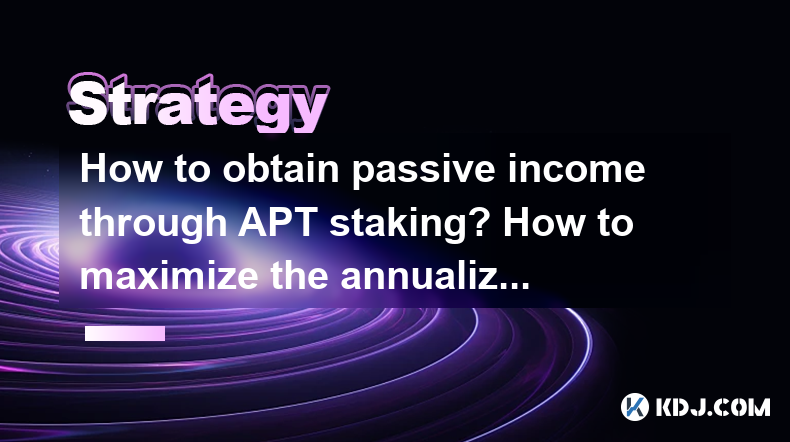-
 bitcoin
bitcoin $122659.385674 USD
0.52% -
 ethereum
ethereum $4484.113342 USD
-0.09% -
 bnb
bnb $1304.229256 USD
-0.85% -
 tether
tether $1.000204 USD
-0.03% -
 xrp
xrp $2.860636 USD
-0.51% -
 solana
solana $227.288799 USD
2.36% -
 usd-coin
usd-coin $0.999805 USD
0.01% -
 dogecoin
dogecoin $0.252837 USD
1.18% -
 tron
tron $0.341149 USD
1.12% -
 cardano
cardano $0.830507 USD
0.33% -
 hyperliquid
hyperliquid $45.792319 USD
0.04% -
 chainlink
chainlink $22.422164 USD
1.55% -
 ethena-usde
ethena-usde $1.000283 USD
0.01% -
 sui
sui $3.511389 USD
0.83% -
 stellar
stellar $0.385276 USD
-0.44%
How to obtain passive income through APT staking? How to maximize the annualized rate of return?
Staking APT tokens on the Aptos blockchain can earn you passive income; choose a reliable platform and validator to maximize your annualized rate of return.
May 04, 2025 at 11:35 pm

Staking APT (Aptos) tokens is a popular method for cryptocurrency enthusiasts to earn passive income. By locking up your APT tokens, you can participate in the validation process of the Aptos blockchain, earning rewards in the form of additional APT tokens. In this article, we will explore how to obtain passive income through APT staking and how to maximize your annualized rate of return.
Understanding APT Staking
APT staking involves holding your APT tokens in a wallet that supports staking. By doing so, you contribute to the security and operation of the Aptos network. In return, you receive staking rewards, which are distributed based on the amount of APT you have staked and the duration of your stake.
To begin staking APT, you need to have APT tokens in your possession. You can acquire APT tokens through various cryptocurrency exchanges or by participating in the Aptos ecosystem. Once you have APT tokens, you can move on to the staking process.
Choosing a Staking Platform
Selecting the right platform for staking APT is crucial for maximizing your returns. There are several platforms available, each with its own set of features and rewards structures. Some popular options include:
- Aptos Official Staking: This is the native staking platform provided by the Aptos project. It offers direct staking with the highest level of security and control.
- Third-Party Staking Services: Platforms like Coinbase, Binance, and Kraken also offer APT staking services. These platforms may provide additional features such as user-friendly interfaces and automated reward distribution.
When choosing a platform, consider factors such as security, user experience, reward rates, and any associated fees. It's important to research and compare different platforms to find the one that best suits your needs.
Setting Up Your Staking Wallet
To stake your APT tokens, you'll need to set up a compatible wallet. Here are the steps to set up your staking wallet:
- Download and Install the Wallet: Choose a wallet that supports APT staking, such as the Aptos Wallet or a compatible third-party wallet like Trust Wallet or MetaMask.
- Create a New Wallet or Import an Existing One: Follow the wallet's instructions to create a new wallet or import an existing one using your recovery phrase.
- Secure Your Wallet: Ensure that your wallet is secured with a strong password and that you have backed up your recovery phrase in a safe place.
- Transfer APT Tokens to Your Wallet: Send your APT tokens from your exchange or other wallets to your staking wallet address.
Once your wallet is set up and funded, you can proceed to stake your APT tokens.
Staking Your APT Tokens
Staking your APT tokens is a straightforward process. Here's how to do it:
- Navigate to the Staking Section: Open your wallet and go to the section dedicated to staking or delegating tokens.
- Select a Validator: Choose a validator to delegate your tokens to. Validators are responsible for processing transactions and maintaining the blockchain. You can select based on their performance, fees, and other criteria.
- Enter the Amount to Stake: Specify the amount of APT tokens you want to stake. You can stake all or a portion of your tokens.
- Confirm the Transaction: Review the staking details and confirm the transaction. Your tokens will be locked in the staking contract, and you will begin earning rewards.
Remember that once you stake your APT tokens, they are locked for a certain period, and you cannot use them for other purposes until you unstake them.
Maximizing Your Annualized Rate of Return
To maximize your annualized rate of return from APT staking, consider the following strategies:
- Compound Your Rewards: Reinvest your staking rewards back into staking to increase your total staked amount. This can lead to higher rewards over time due to the compounding effect.
- Choose High-Performing Validators: Select validators with a strong track record of performance and reliability. Validators with lower fees and higher uptime can result in higher net rewards for you.
- Monitor and Adjust: Keep an eye on the performance of your chosen validators and the overall staking environment. Be ready to switch validators or adjust your staking strategy if needed to optimize your returns.
- Diversify Your Staking: Consider staking with multiple validators to spread risk and potentially increase your overall returns. Diversification can help mitigate the impact of any single validator underperforming.
By implementing these strategies, you can enhance your passive income from APT staking and achieve a higher annualized rate of return.
Managing and Unstaking Your APT Tokens
At some point, you may need to unstake your APT tokens, either to use them for other purposes or to switch to a different staking strategy. Here's how to manage and unstake your tokens:
- Monitor Your Staking Rewards: Regularly check your staking rewards and keep track of your total earnings.
- Initiate Unstaking: When you're ready to unstake, go to the staking section of your wallet and select the option to unstake or withdraw your tokens.
- Wait for the Unstaking Period: There may be a waiting period before your tokens are fully unstaked and available for use. This period can vary depending on the platform and the specific staking contract.
- Withdraw Your Tokens: Once the unstaking period is over, you can withdraw your APT tokens back to your wallet or transfer them to an exchange.
It's important to plan your unstaking carefully, as you may miss out on staking rewards during the unstaking period.
Frequently Asked Questions
Q: Can I stake APT tokens on multiple platforms simultaneously?A: Yes, you can stake APT tokens on multiple platforms simultaneously, provided that you have enough tokens to meet the minimum staking requirements for each platform. However, you should manage your stakes carefully to avoid overcommitting your tokens.
Q: What happens if a validator I've staked with goes offline or underperforms?A: If a validator you've staked with goes offline or underperforms, your staking rewards may be reduced. In some cases, you may also face penalties. It's important to monitor your validators' performance and be prepared to switch to a different validator if necessary.
Q: Are there any risks associated with APT staking?A: Yes, there are risks associated with APT staking. These include the potential for validator downtime, slashing penalties for validator misconduct, and the risk of changes in the staking reward structure. Always research and understand these risks before staking your APT tokens.
Q: How often are staking rewards distributed?A: The frequency of staking reward distribution can vary depending on the platform and the specific staking contract. Some platforms distribute rewards daily, while others may do so weekly or monthly. Check the details of your chosen platform to understand the reward distribution schedule.
Disclaimer:info@kdj.com
The information provided is not trading advice. kdj.com does not assume any responsibility for any investments made based on the information provided in this article. Cryptocurrencies are highly volatile and it is highly recommended that you invest with caution after thorough research!
If you believe that the content used on this website infringes your copyright, please contact us immediately (info@kdj.com) and we will delete it promptly.
- Dogecoin, Bitcoin, Ethereum: Decoding the Crypto Crystal Ball
- 2025-10-09 14:40:12
- Whale Profit, Memecoins, and PEPE Volatility: A New Yorker's Take
- 2025-10-09 12:25:16
- BNB, MAGACOIN FINANCE, and ROI: Catching the Next Wave
- 2025-10-09 12:45:12
- BlockDAG, Formula 1, and Crypto Investing: A Winning Combination?
- 2025-10-09 12:25:16
- Shayne Coplan, Polymarket, and the POLY Token: Is Launch Imminent?
- 2025-10-09 12:30:03
- Trump Coin ETF, DTCC Listing, TRPC Ticker: A New Era for Political Meme Coins?
- 2025-10-09 11:40:03
Related knowledge

Practical parameter settings for a Bitcoin multi-timeframe moving average system
Sep 18,2025 at 10:54pm
Optimizing Timeframe Combinations for Bitcoin Trading1. Selecting appropriate timeframes is crucial when building a multi-timeframe moving average sys...

How can I filter out false breakouts in Dogecoin high-frequency trading?
Sep 22,2025 at 01:00am
Understanding False Breakouts in Dogecoin Trading1. A false breakout occurs when Dogecoin's price appears to move beyond a defined support or resistan...

Techniques for identifying tops and bottoms in the Bitcoin on-chain NVT model
Sep 20,2025 at 07:54pm
Understanding the NVT Model in Bitcoin Analysis1. The Network Value to Transactions (NVT) ratio is often described as the 'P/E ratio' of the cryptocur...

What does the surge in open interest in Bitcoincoin futures mean?
Sep 20,2025 at 11:18pm
Understanding the Surge in Dogecoin Futures Open Interest1. A surge in open interest within Dogecoin futures indicates a growing number of active cont...

How can I use the Ethereum USDT premium to gauge market sentiment?
Sep 18,2025 at 11:55pm
Understanding the Ethereum USDT Premium1. The Ethereum USDT premium refers to the price difference between USDT (Tether) traded on Ethereum-based plat...

What should I do if Ethereum staking yields decline?
Sep 20,2025 at 06:18am
Understanding the Causes Behind Declining Ethereum Staking Yields1. The Ethereum network transitioned to a proof-of-stake consensus mechanism with the...

Practical parameter settings for a Bitcoin multi-timeframe moving average system
Sep 18,2025 at 10:54pm
Optimizing Timeframe Combinations for Bitcoin Trading1. Selecting appropriate timeframes is crucial when building a multi-timeframe moving average sys...

How can I filter out false breakouts in Dogecoin high-frequency trading?
Sep 22,2025 at 01:00am
Understanding False Breakouts in Dogecoin Trading1. A false breakout occurs when Dogecoin's price appears to move beyond a defined support or resistan...

Techniques for identifying tops and bottoms in the Bitcoin on-chain NVT model
Sep 20,2025 at 07:54pm
Understanding the NVT Model in Bitcoin Analysis1. The Network Value to Transactions (NVT) ratio is often described as the 'P/E ratio' of the cryptocur...

What does the surge in open interest in Bitcoincoin futures mean?
Sep 20,2025 at 11:18pm
Understanding the Surge in Dogecoin Futures Open Interest1. A surge in open interest within Dogecoin futures indicates a growing number of active cont...

How can I use the Ethereum USDT premium to gauge market sentiment?
Sep 18,2025 at 11:55pm
Understanding the Ethereum USDT Premium1. The Ethereum USDT premium refers to the price difference between USDT (Tether) traded on Ethereum-based plat...

What should I do if Ethereum staking yields decline?
Sep 20,2025 at 06:18am
Understanding the Causes Behind Declining Ethereum Staking Yields1. The Ethereum network transitioned to a proof-of-stake consensus mechanism with the...
See all articles










































































